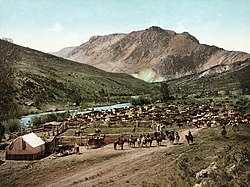Open range

In the practice of the Westwern United States, open range is a rangeland where cattle can roam freely on the loose regardless the land ownership, without any prohibition or requirement of any compensaion for grazing. According to the open-range laws, only a legally erected fence can exclude the rangeland from this practice, hence the term, "open" range. In contrast, in most eastern states, livestock have always had to be fenced in by the owners or herded by herdsmen. The Western open-range tradition originated from the early practice of allowed unregulated grazing in newly acquired western territories, which was gradually adopted into the laws of Western states.[1]
Over time, as the Western lands became more developed (railroads, mining, farming, etc.) the open range laws started to be challenged and were significantly curtailed, but they still exist in most western states.[1]
Open-range herding has also been practiced in other areas, such as Caribbean and South Carolina.[2][3] In fact this tradition has been known in Mexico since the 19th century, and some argue it may have contributed to the open range practice in the American West.[1]
History and practice


Unlike the eastern lands, the newly acquired "Wild West" was vast undeveloped, uncultivated, undivided, mostly treeless government-owned territories, with scarse, widely separated sources of water. Livetock was allowed to graze without cost on governmant lands. Until the invention of barbed wire in the 1870s, it was more practical to fence the livestock out of the developed land, rather than to fence it in.[1]
Free roaming range cattle was calved, driven between pastures and to the markets by the cowboys. The ownership of the cattle was identified by branding.[1]
In a cow-car collision on a roadway across an open range, the rancher is not liable, if he can pove that he was reasonably diligent to keep the cattle on his land. At the same time, statistics shows that chances are much higher to hit a wild animal than livestock on the road.[4]
On the other hand, if a livestock broke through a "legal fence" (defined by law in terms of height, post spacing, etc.), then the livestock owner is liable for damages of the fenced property. And vice versa, no damages can be sought in absence of the "legal fence." An exception was for "unruly" animals (e.g., breeding bulls and stallions), which were supposed to be restricted by the owner.[1]
The invention of barbed wire had brought much drama in open range. It turned out that fencing huge expanses was cheaper than hiring cowboys for handling cattle, and indiscriminate fencing of federal lands proceeded in 1880s, often without any regards to tother needs, such as mail delivery and other kinds of livestock. Various state statutes, as well as vigilantes (see "Fence Cutting War"), tried to combat it with varying success, until the 1885 legislation outlawed the enclosure of federal land. By 1890 illegal fencing has been mostly removed.[1][5]
Modern times

In modern times, free roaming cattle provide much nuisance and danger in urban areas, freeways, and other developed areas. Some states, such as California, allow open ranging only in some areas.[4]
In Arizona, livetock must be fenced in in incorporated areas, but still is a nuisance, e.g., for suburbs.[4]
Therefore in some states, such as Arizona, bills are being pushed "to get rid of this antiquated law from 19th century." This is met with the opposition, which says that "eliminating the law would put undue hardship on ranchers.[4]
See also
- Range war
- Category:Range wars in the United States
- Roundup
- Cattle drives in the United States
- Agricultural fencing
- Drift fence
References
- ^ a b c d e f g Gordon Morris Bakken (ed.), "Law in the western United States", 2000, ISBN 0806132159, Chapter 3, "Open Range Law in the American West", by Roy H. Andes
- ^ The Role of Black Barbudans in the Establishment of Open-Range Cattle Herding in the Colonial Caribbean and South Carolina, Journal of Historical Geography 35 (2009): 330-49. doi:10.1016/j.jhg.2008.08.003
- ^ With Amy E. Potter, Renegotiating Barbuda's Commons: Recent Changes in Barbudan Open-Range Cattle Herding, Journal of Cultural Geography 27 (2010): 129-50. doi:10.1080/08873631.2010.494404
- ^ a b c d "Arizona Rethinking Open Range Laws", by Marc Lacey, New York Times, October 11, 2010
- ^ Anderson, Terry Lee and Leal, Donald (2001). Free Market Environmentalism. 0-312-23503-8. pp. 30–31.
{{cite book}}: CS1 maint: multiple names: authors list (link)
